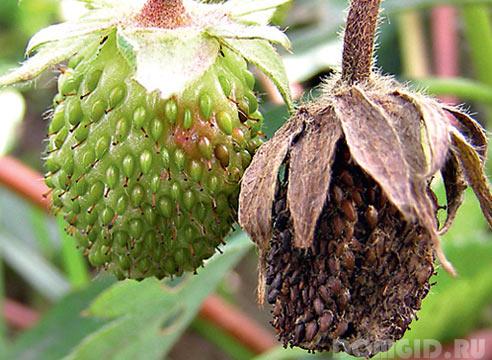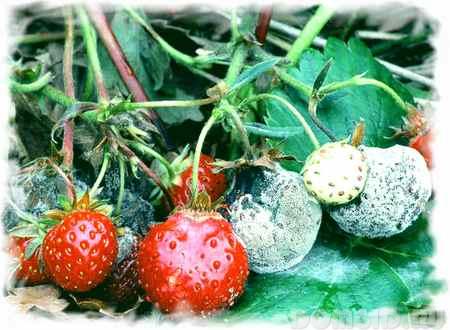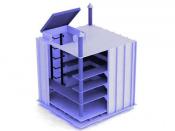Search
Login
Strawberries: strawberry diseases, strawberry pests. Ways to deal with diseases and pests of strawberries
All professional gardeners engaged in the cultivation of strawberries, sooner or later had to deal with the appearance on the bushes of wild strawberries of unusual spots, shriveled leaves that had lost their former attractiveness, twisted shoots and small insects. All this once again proves a huge variety of diseases and pests that affect strawberries. After reviewing the materials presented in this article, you will learn about the most common pests and diseases of strawberries, as well as ways to prevent and control them.
Content
- Strawberry. A variety of diseases and pests
- Read more about nematodes, strawberry mites and weevils video
- Strawberry Diseases and the harm they cause
- Caution! Powdery mildew
- Disease and Pest Prevention
Strawberry. A variety of diseases and pests
Many people know that strawberries, more often than other garden berry crops, are attacked by pests. The most dangerous are strawberry and spider mite species, various representatives of nematodes, as well as larvae of May beetles that live in the upper soil layer. The weevil weevil and its cousins, green, raspberry-strawberry weevils, as well as the mowing alfalfa and strawberry sawfly, can cause significant damage to berry plantations even in small quantities.

Read more about nematodes, strawberry mites and weevils
Common pests of garden strawberries are nematodes. These are small representatives of roundworms, which can even be seen with the naked eye. The main damaging factor of nematodes is the enzymes of their vital functions, introduced by the nematode into plant cells, which then cause deep metabolic disturbances in plant organisms.

The main criteria for the defeat of wild strawberries by roundworms are twisted leaves that have undergone deformation, shortened cuttings, as well as the appearance of specific thickenings and growths of the stem. Plants affected by the nematode lose their ability to bear fruit, and if the berries still appear, they are often small and deformed.

In order to ensure maximum protection of strawberries from strawberry nematode damage, seedlings immediately before planting in open ground should be abundantly moistened with warm water, the temperature of which does not exceed 47 degrees, for 10 minutes and then cold for 15 minutes. It is possible to plant strawberries in the place where the nematode’s defeat was detected no earlier than seven years later, and planted bushes must be surrounded with lime.

A dangerous strawberry pest is considered to be a strawberry tick, a small yellowish pest that is not visible to the naked eye. In the spring period of time associated with strawberry vegetation, the tick lays larvae on young leaves, which, coming out of the eggs, infect strawberry leaves, thereby leading to wrinkling and stunting.

To combat strawberry mites, it is necessary to produce spring processing of strawberries from pests and diseases, which consists in processing young leaves with colloidal sulfur or karbofos. Subsequent processing is performed after flowering begins. For these purposes, experts advise using the drug Neoron.
Sallow and strawberry-raspberry weevils are beetles that winter in the upper layers of the soil, and in the spring they gnaw young leaves and buds, thereby causing irreparable damage to the strawberry garden. Weevil larvae also contribute to damage to horticultural crops. The fight against weevil beetles consists in spraying strawberries with a 0.3% emulsion of 50% malathion, while 30 grams of the drug must be diluted in 10 liters of water.


Strawberry Diseases and the harm they cause
Strawberry diseases have no less damaging effects on garden strawberry culture than pests. They are also extremely diverse and cause irreparable damage to gardeners if preventive measures are not taken in time. Strawberry diseases and their treatment are those fundamentals that everyone who wants to get a high yield of strawberry should know.

Powdery mildew, various leaf spots, often brown and white, fusarium and late blight wilting, as well as gray rot and damage to the root apparatus are considered the most dangerous fungal and bacterial lesions of the garden-strawberry culture.

Caution! Powdery mildew
The defeat of powdery mildew consists in the formation of a white coating mainly on the aerial parts of the plant, and contributes to the twisting and wrinkling of the marginal part of the leaves, which subsequently acquire a purple hue and become covered with powdery bloom. Powdery defeat also adversely affects flowering, as the natural pollination of strawberries is inhibited, and the resulting fruits are covered with a powdery coating. Processing strawberries in the spring from diseases, and in particular from powdery mildew, involves spraying the bushes with a copper-soap emulsion, the composition of which is represented by 15 liters of water, 20-30 grams of soap and copper sulphate.

The first and main signs of fusarium and late blight wilt are manifested by necrotic changes along the edges of the leaves, their gradual drilling with subsequent death. The axial cylinder of the plant turns red, and the leaves become cup-shaped and have a grayish tint.

Gray rot is also a common fungal infection, which manifests itself in the appearance of dark grayish and brown spots on the berries, and the berries and leaves affected by the pathogen of gray rot decay and become covered with a gray coating.

The most frequently discovered disease that gardeners encounter when cultivating strawberries is white leaf spot. It is caused by a fungal pathogen and affects mainly leaf blades, antennae, petioles and stalks, on which small oval spots of red-brown color subsequently appear, which eventually become white with a dark red rim.

Disease and Pest Prevention
Preventive measures to protect strawberries from disease include a number of mandatory requirements that must be followed by anyone who wants to get a high yield.
1.Specialists advise growing varieties with proven genetic resistance to the defeat of various berry rot, while the seedlings should be clean. A prerequisite is the planting of different varieties of strawberries, at a distance of not less than 1.5-2 m from each other;

2. It is necessary to cultivate garden strawberries in one territory for no longer than two years. This feature of planting will prevent the accumulation of pests and an outbreak of disease;
3. When planting, it is necessary to remember that the optimum plant density is observed. It is important to remember that the width of the row should not exceed 30 centimeters, which will ensure optimal air flow and high purge and illumination. Compliance with this nuance will prevent the accumulation of excess moisture, thereby helping to avoid the development of many diseases of strawberries;

4. The fight against diseases and pests also provides for a number of agrotechnical measures, which include the destruction of dry overwintered leaves that have been affected, spring cultivation of crops with a 3% solution of Bordeaux mixture, timely tillage, as well as quality cleaning of weeds from the crop.
After harvesting, in order to reduce the risk of strawberry infection, it is recommended that the next season, soil treatment with Euparen, Switch or Topaz is carried out, which will be the final stage in the fight against diseases and pests of strawberries this season.






